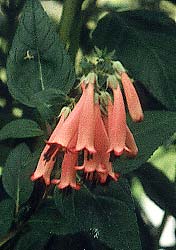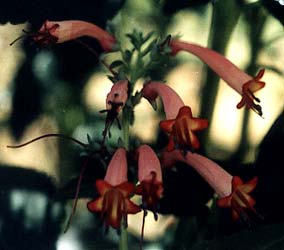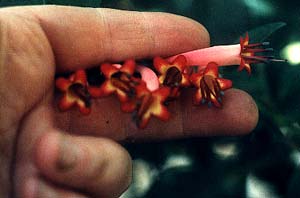
'Winchester Fanfare'
Cape Fuchsia
"Earth laughs in flowers."
-Ralph Waldo Emerson
(1803-1882)
(1803-1882)
The first photo was taken in June; the second & third are July photos, in 2002. These show a Cape Fuschia cultivar which is a hybrid of P. aequalis & P. capensis, sold as P. x rectus 'Winchester Fanfare.'
'Winchester Fanfare' was given to me as a start off of a five foot tall very upright shrub. In our garden the little shrub sprang up to the same height swift as could be. It has salmon-pink or dusty coral-pink tubular flowers with yellow throat, & large dark green leaves. It is much taller & more upright with larger (four inch) leaves than our P. x rectus 'Pink Elf.'
 I didn't actually know what this shrub was when I was given the start. I was told only "It's a fucshia," & even that isn't quite true since Cape Fuchsias aren't true fuchsias at all. So I wasn't sure how best to care for it. I made a hasty assumption it would like shade, & planted it under the Paperbark Maple, where it sprang up to four feet tall right away, then its second year shot up to six feet, larger than is typical.
I didn't actually know what this shrub was when I was given the start. I was told only "It's a fucshia," & even that isn't quite true since Cape Fuchsias aren't true fuchsias at all. So I wasn't sure how best to care for it. I made a hasty assumption it would like shade, & planted it under the Paperbark Maple, where it sprang up to four feet tall right away, then its second year shot up to six feet, larger than is typical.Its size surprised me as it had begun crowding more sensitive shade perennials I didn't want crowded. I began pondering whether or not to move it. I had in the meantime figured out what it was, & realized I'd guessed wrong about its needs.
While making every heroic effort to establish itself in that shady spot, its most upright stems became top-heavy & some of these tipped over in a messy attitude. It was struggling for more light, & when I figured out it was a Cape Fuchsia cultivar, I knew I really should have planted it in more sun. It certainly grew swiftly in the shade, but the bloom period had been shorter than it should've been & during its second year it became far too weak-stemmed & rangy. So early in autumn, I made the decision to move it to a dappled-sunlight location.
 I cut it way back before the move. Despite the lateness of the year, it never went dormant but grew back rapidly during the rest of autumn & remained very sharply green & fresh through winter. Now that it has more sun I'm expecting it to remain a bit more compact & sturdy, with fountaining stance rather than floppy. The bloom period should last at least to summer's end with possible autumn rebloom.
I cut it way back before the move. Despite the lateness of the year, it never went dormant but grew back rapidly during the rest of autumn & remained very sharply green & fresh through winter. Now that it has more sun I'm expecting it to remain a bit more compact & sturdy, with fountaining stance rather than floppy. The bloom period should last at least to summer's end with possible autumn rebloom.I wouldn't ordinarily have given it the hard pruning in autumn; that was a special case since I had to transplant it, &t it was a little bit surprising that such a late pruning induced sudden regrowth. Usually I prune it in spring. 'Winchester Fanfare' is strongly evergreen through the winter, & there's no reason to lose its pleasing presence prematurely.
Puget Sound weather is so moderate, both the 'Winchester Fanfare' & the dwarf 'Pink Elf' make it all the way to the start of March looking very leafy & bright, showing no signs of winter damage. But during March, especially if a pleasant few days are followed by unexpected late frosts, a good pruning quite suddenly becomes essential, as leaves darken & become spotty. By then, without attention, the Cape Fuchsias looks just awful.
So late in January or early in March is the best time to cut it back dramatically. It will grow back with extreme rapidity, getting much bigger & bushier each year.